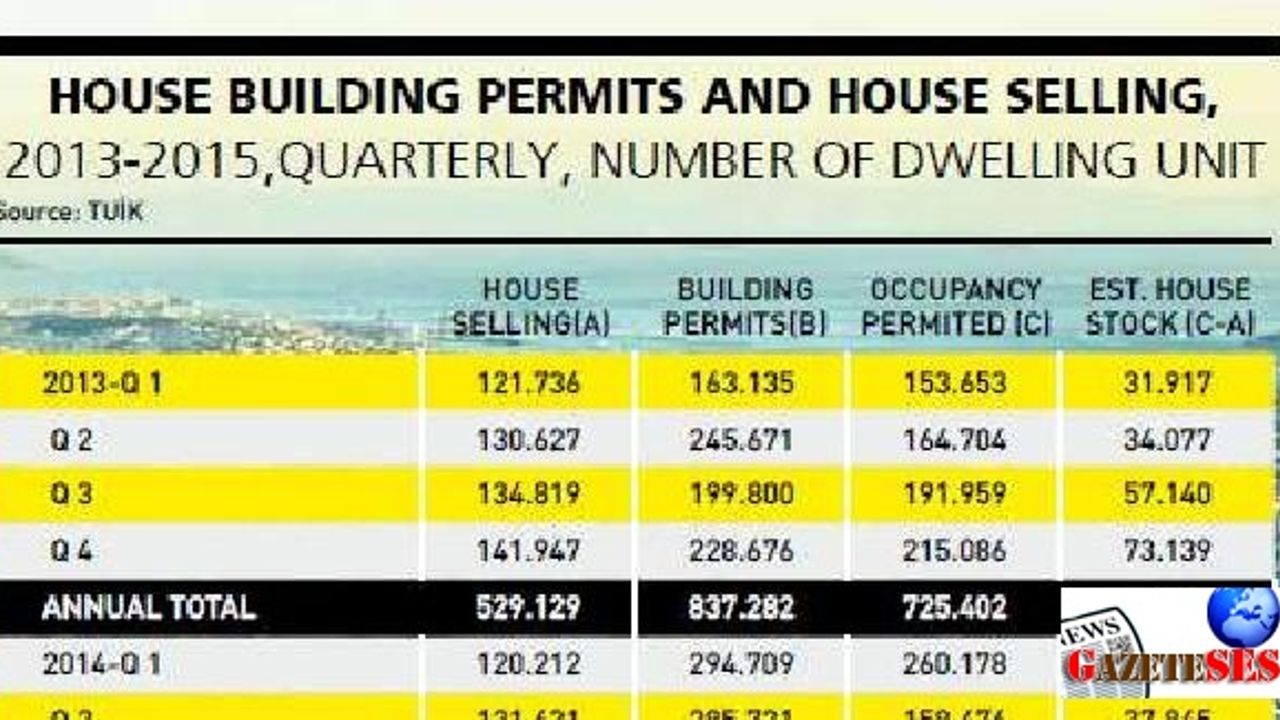Mustafa Sönmez - Hürriyet Daily News / Istanbul, June 1 () - Data released one day apart last week has revealed that there is a rapid rise in home sales, as well as a sharp decline in the intention to build new ones. This situation will hopefully ease the concern that constructions riding at full speed regardless of the sales tempo will create a balloon. In other words, the housing industry is in a “recovery” process.
It’s not only the economic but also the political conjuncture that is forcing this recovery. While campaigns are being launched to sell the finished houses, there is no rush to start new constructions. At the very least, there is a wait for the results of the June 7 elections.
According to the Turkish Statistical Institute (TÜİK), in the first three months of 2015, the number of building permits issued by local governments for apartments decreased 41.2 percent compared to the same period last year. In the first three months of 2014, there was an increase of 87 percent compared to the first three months of 2013.
While in 2015 between January and March, the total area of the buildings receiving occupancy permits was 37.1 million square meters, 54 percent of which were residential units.
The breakdown of occupancy permits according to provinces is that Istanbul leads with 8.7 million square meters (23.4 percent). Ankara follows at 3.1 million square meters (8.4 percent) and İzmir comes third at 1.7 million square meters (4.5 percent). The provinces with the lowest rate of building permits are the poor southeastern provinces of Hakkari, Tunceli and Şırnak.
Revival in sales
While a sharp stop in housing constructions has been observed, on the other hand, a revival in home sales looks interesting. In April, the total number of first- and second-hand home sales reached 119,000. An increase of 43 percent in home sales was recorded compared to the same month last year. In the sale of mortgaged units, in other words, in the purchases done by bank loans, an increase of nearly 100 percent occurred compared to April of last year. The 119,000 sales figure in April is the second highest one in one month after the record of 135,000 units in December 2014.
Home sales in the first four months were 417,000 units, corresponding to a 22 percent increase compared to the 341,000 units of the same period last year. However, one needs to remember that sales in the first four months of 2014 had declined compared to the same period in 2013.
Sales in the first four months of 2013 were around 369,000; in other words, this year’s sales are 13 percent more than 2013 sales.
Why the revival?
The upsurge in sales is based on the perception that today is better than tomorrow in terms of backdating the demand and timing.
Experts in the housing market cite the factors as such: There is no expectation of a decrease in house prices; on the contrary the expectation that prices would increase is stronger. Annual rises in housing prices nearing 15 percent have multiplied the annual consumer prices at the 7 or 8 percent course. Also, it is not expected that interest rates in loans and mortgage interest rates will fall.
The indefiniteness concerns for the future seem important in home purchases. Estimates on the results of the general elections in June 7 are that the ruling Justice and Development Party (AKP) will not be able to govern alone. This is considered as a factor that would increase the indefiniteness in the economy and move forward purchase decisions.
Search for balance
Housing has been the locomotive of the AKP government for 12 years while also creating a fear of a balloon that is ready to explode at any minute. The most popular questions were always “Where does the demand for these many units come from; are they being sold; are the stocks increasing?” Since there is no inventory for housing stocks in Turkey, the answers have always been weak.
Since 2014, construction permits demanded from local governments show that builders are cautious. Instead of full speed, they are in a “wait and see” mode.
In the first quarter of 2014, before the local elections on March 30, there was a rush for building permits.
This was attributed to concerns for after elections; such as possible changes in local governments and a possible increase in the necessary requirements for permits. As a matter of fact, 295,000 units in the first quarter of 2014 is the peak of permits. The number of permits went down in subsequent quarters and the figure for the whole year was 1,014,000. In other words, 29 percent of building permits in 2014 were issued in the first quarter.
Occupancy permits and stocks
There was a fall in the number of units that have been completed, ready to be occupied and allowed for residence. Municipalities issue occupancy permits and the number of permits issued in the first quarter of this year was 155,000, which was below expectations. It is known that in any season, units that have been given building permits, in normal circumstances, are completed in approximately one to 1.5 years, after which occupancy permits are issued.
In the first quarter of 2014, the number of units on which construction was started was nearly 295,000 and a significant portion of these units should have been completed this year. Thus, the 155,000 units that are ready for tenancy are very low compared to the 295,000 units for which construction permission has been given.
But again, data from the first quarter of 2015 reveals that there is no significant rise in housing stocks. First-hand housing sales in the first quarter of 2015 were 130,000 units, while the number of occupancy permits issued during this period was 155,000. In other words, there was an increase of only 25,000 units in the stock. The number of unsold extra units added to the stock in 2013 was 50,000 in each quarter and 56,000 in 2014; this went down to 25,000 in the first quarter of 2015.
This can be interpreted as the erosion of stock together with the slowdown in construction and that the fear of an explosion in the housing balloon has been taken under control. However, one detail is worth looking into. The first quarter of 2014 was not an ordinary quarter; for instance, the number of occupancy permits issued in the first quarter was 260,000 units, while this figure fell to 160,000 units in the second quarter. For this reason, it would not be correct to simply look at the first quarter of last year alone.
The issue and the future
The housing issue is not over – only the data unique to this first quarter of the year is soothing. However, the balance issue looks as if it will be solved in the medium term.
In order to curb risks, more cautious moves taking into consideration the housing stocks are needed; slowing down housing investments are also needed as well as developing measures to finish stocks.
It is not easy to take effective measures overnight to lower the housing stocks to a reasonable level. Distrust in the short-term economy and the concern of things getting worse prioritize housing demands and sales are up. However, normalizing an intensified demand and stabilizing it are only possible by building confidence in the economy in the medium term, increasing the income level, opening credit channels and further decreasing interest rates.
(Table)




















